
Leo the Lion via Constellation of Words.
See how – on old star charts like the one above – the tail of the constellation Leo the Lion curves around? There’s a star there, Beta Leonis or Denebola, whose name means tail. Yet – on the dome of the sky – the Lion’s Tail used to extend out straight behind Leo, and the constellation of the Lion encompassed a much-larger area of the sky. The Greek-Egyptian astronomer Ptolemy and others considered a modern-day constellation – which we call Coma Berenices, site of an actual star cluster visible in a dark sky – as the tuft at the end of Leo’s tail. Coma Berenices was considered a part of Leo until only a few hundred years ago, when it was first listed as a separate constellation.
You need a dark sky to appreciate the constellation Coma Berenices. If you have one, you’ll find that the star cluster in its midst – designated Melotte 111 but usually called simply the Coma Star Cluster – is very beautiful.
Stars in Leo the Lion pointing to the Coma Star Cluster, captured in 2013 by EarthSky Facebook friend Zhean Peter Nacionales in the Philippines.
The official constellation is relatively new, but the lore behind the constellation is old. The story goes that an ancient Egyptian queen, Berenice, feared for her husband’s life as he went into battle. She prayed to Aphrodite, promising to cut off her long, luxurious curls if the king returned safely. He did, and Berenice kept her promise and cut off her hair, placing it as a sacrifice on Aphrodite’s altar.
But the next day the hair was gone!
The king was enraged that the temple priests had not protected the precious locks. A quick-thinking astronomer saved the day, or rather night, by pointing to the cascading stars at the end of Leo’s tail. He told the king that these were the queen’s tresses placed in the sky by Aphrodite for all to see.
The king and queen were appeased, and no priests were beheaded.
Leo lost his tail … and, ultimately, we gained a constellation.
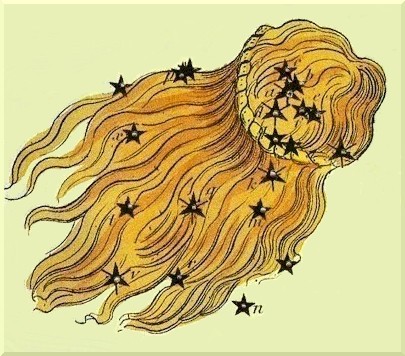
The constellation Coma Berenices (Berenice’s Hair), via Constellation of Words.
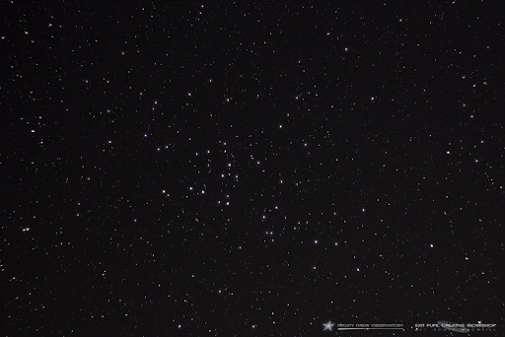
The Coma Star Cluster as captured in 2014 by Scott MacNeill of the Frosty Drew Observatory and Sky Theater. The Coma Star Cluster is estimated to be about 288 light-years away and has at least 37 known stars that are 400 million years old.
How can you see these wonderful stars?
Do you know how to use the pointer stars in the Big Dipper to locate Polaris, the North Star? Instead of going northward from the pointer stars to Polaris, go southward to find the constellation Leo.
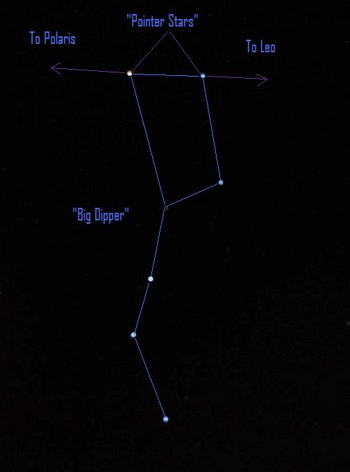
An imaginary line drawn between the pointer stars in the Big Dipper - the two outer stars in the Dipper's bowl - points in one direction toward Polaris, the North Star, and in the opposite direction toward Leo.
Then use the constellation Leo to find the constellation Coma Berenices, as shown on the chart below:
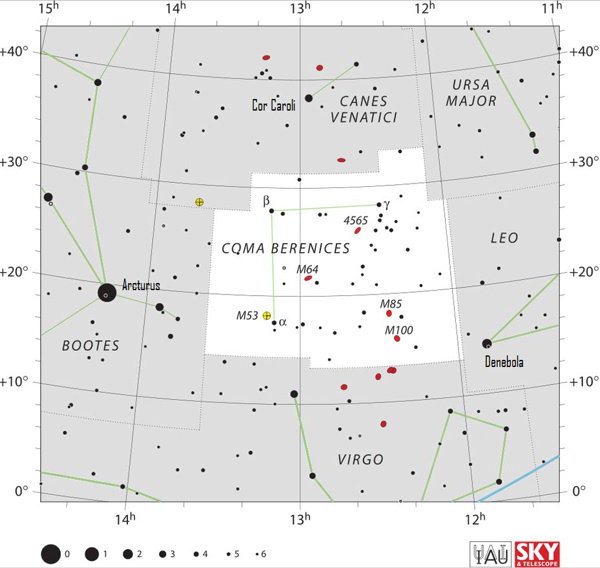
View larger. | The constellation Coma Berenices via Wikipedia.
Viewing Tip: To enhance your view of the Coma Star Cluster, take a paper towel tube or roll up some dark paper into a tube and place it to your eye. The tube will shield your eye from the glare of any ground lights. Binoculars or opera glasses will also lead to a better viewing experience.
Enjoying EarthSky so far? Sign up for our free daily newsletter today!
Beyond the visible stars in the Coma cluster is something else: a vast region of galaxies. Read more: Coma Cluster of galaxies in Coma BerenicesThere’s also a vast cluster of galaxies located in the direction of the constellation Coma Berenices. Here is a majestic face-on spiral galaxy located deep within the Coma Cluster. Read more about the Coma galaxy cluster. Image via NASA
Bottom line: The constellation Leo once had a tail, a clump of faint stars. Now these same stars are known as Coma Berenices, the hair of a queen.
Star-hop from Leo to the Coma star cluster
from EarthSky https://ift.tt/2qjilMB

Leo the Lion via Constellation of Words.
See how – on old star charts like the one above – the tail of the constellation Leo the Lion curves around? There’s a star there, Beta Leonis or Denebola, whose name means tail. Yet – on the dome of the sky – the Lion’s Tail used to extend out straight behind Leo, and the constellation of the Lion encompassed a much-larger area of the sky. The Greek-Egyptian astronomer Ptolemy and others considered a modern-day constellation – which we call Coma Berenices, site of an actual star cluster visible in a dark sky – as the tuft at the end of Leo’s tail. Coma Berenices was considered a part of Leo until only a few hundred years ago, when it was first listed as a separate constellation.
You need a dark sky to appreciate the constellation Coma Berenices. If you have one, you’ll find that the star cluster in its midst – designated Melotte 111 but usually called simply the Coma Star Cluster – is very beautiful.
Stars in Leo the Lion pointing to the Coma Star Cluster, captured in 2013 by EarthSky Facebook friend Zhean Peter Nacionales in the Philippines.
The official constellation is relatively new, but the lore behind the constellation is old. The story goes that an ancient Egyptian queen, Berenice, feared for her husband’s life as he went into battle. She prayed to Aphrodite, promising to cut off her long, luxurious curls if the king returned safely. He did, and Berenice kept her promise and cut off her hair, placing it as a sacrifice on Aphrodite’s altar.
But the next day the hair was gone!
The king was enraged that the temple priests had not protected the precious locks. A quick-thinking astronomer saved the day, or rather night, by pointing to the cascading stars at the end of Leo’s tail. He told the king that these were the queen’s tresses placed in the sky by Aphrodite for all to see.
The king and queen were appeased, and no priests were beheaded.
Leo lost his tail … and, ultimately, we gained a constellation.

The constellation Coma Berenices (Berenice’s Hair), via Constellation of Words.

The Coma Star Cluster as captured in 2014 by Scott MacNeill of the Frosty Drew Observatory and Sky Theater. The Coma Star Cluster is estimated to be about 288 light-years away and has at least 37 known stars that are 400 million years old.
How can you see these wonderful stars?
Do you know how to use the pointer stars in the Big Dipper to locate Polaris, the North Star? Instead of going northward from the pointer stars to Polaris, go southward to find the constellation Leo.

An imaginary line drawn between the pointer stars in the Big Dipper - the two outer stars in the Dipper's bowl - points in one direction toward Polaris, the North Star, and in the opposite direction toward Leo.
Then use the constellation Leo to find the constellation Coma Berenices, as shown on the chart below:

View larger. | The constellation Coma Berenices via Wikipedia.
Viewing Tip: To enhance your view of the Coma Star Cluster, take a paper towel tube or roll up some dark paper into a tube and place it to your eye. The tube will shield your eye from the glare of any ground lights. Binoculars or opera glasses will also lead to a better viewing experience.
Enjoying EarthSky so far? Sign up for our free daily newsletter today!
Beyond the visible stars in the Coma cluster is something else: a vast region of galaxies. Read more: Coma Cluster of galaxies in Coma BerenicesThere’s also a vast cluster of galaxies located in the direction of the constellation Coma Berenices. Here is a majestic face-on spiral galaxy located deep within the Coma Cluster. Read more about the Coma galaxy cluster. Image via NASA
Bottom line: The constellation Leo once had a tail, a clump of faint stars. Now these same stars are known as Coma Berenices, the hair of a queen.
Star-hop from Leo to the Coma star cluster
from EarthSky https://ift.tt/2qjilMB

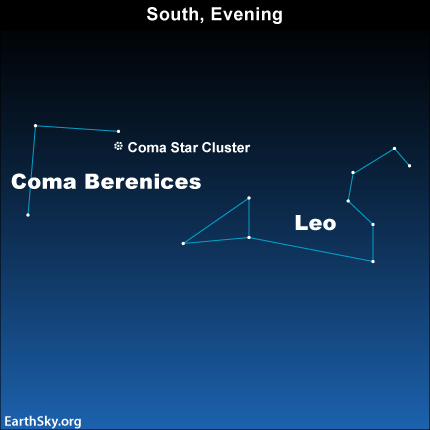
Aucun commentaire:
Enregistrer un commentaire